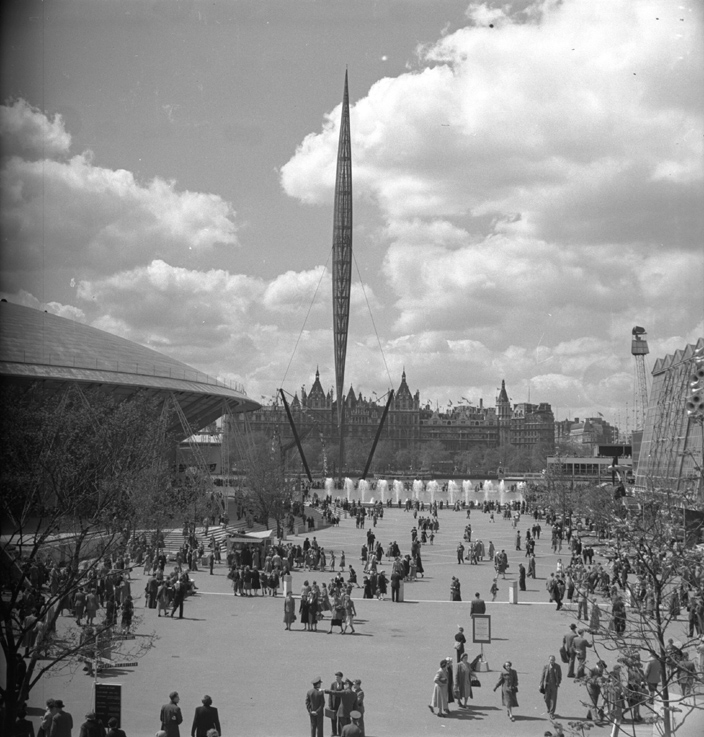Tensegrity structural systems
Tensegrity is a structural design principle that applies to a structure which can be stabilised entirely by internal pre-stress. This pre-stress is created by a discontinuous set of compression elements being opposed and balanced by a continuous tensile force.
In essence, a net of continuous tension cables or tendons (the tensioned elements), hold in place, and are themesleves held in place by, a series of discontinous bars or struts (the compressed elements).
The pioneering architect Buckminster Fuller coined the term tensegrity in the 1960s, as a combination of ‘tensional integrity’. However, the American sculptor Kenneth Snelson has long-claimed that Fuller took credit for his original idea of ‘floating compression’. Snelson defines tensegrity as follows:
| ‘Tensegrity describes a closed structural system composed of a set of three or more elongate compression struts within a network of tension tendons, the combined parts (are) mutually supportive in such a way that the struts do not touch one another, but press outwardly against nodal points in the tension network to form a firm, triangulated, prestressed, tension and compression unit.’ |
This combination of balanced elements produces an exceptionally rigid structure made up of members that do not experience bending moments. Members are loaded only in pure compression or pure tension, and will fail only if cables yield or rods buckle.
A famous example of a tensegrity structure was the Skylon, exhibited at the Festival of Britain in 1951 [see top image]. The tower was held in position by six cables, three of which were at the bottom and determined its location, while the other three were at the top and maintained its verticality.
One of the first uses of tensegrity in architecture was Spodek, an entertainment venue in Poland, designed by architects Maciej Gintowt and Maciej Krasiski in the 1960s. The roof was an inclined surface, the circumference of which was held up by a system of cables.
[edit] Related articles on Designing Buildings
Featured articles and news
The benefits of engaging with insulation manufacturers
When considering ground floor constructions.
Lighting Industry endorses Blueprint for Electrification
The Lighting Industry Association fully supports the ECA Blueprint as a timely, urgent call to action.
BSRIA Sentinel Clerk of Works Training Case Study
Strengthening expertise to enhance service delivery with integrated cutting-edge industry knowledge.
Impact report from the Supply Chain Sustainability School
Free sustainability skills, training and support delivered to thousands of UK companies to help cut carbon.
The Building Safety Forum at the Installershow 2025
With speakers confirmed for 24 June as part of Building Safety Week.
The UK’s largest air pollution campaign.
Future Homes Standard, now includes solar, but what else?
Will the new standard, due to in the Autumn, go far enough in terms of performance ?
BSRIA Briefing: Cleaner Air, Better tomorrow
A look back at issues relating to inside and outside air quality, discussed during the BSRIA briefing in 2023.
Restoring Abbotsford's hothouse
Bringing the writer Walter Scott's garden to life.
Reflections on the spending review with CIAT.
Retired firefighter cycles world to raise Grenfell funds
Leaving on 14 June 2025 Stephen will raise money for youth and schools through the Grenfell Foundation.
Key points for construction at a glance with industry reactions.
Functionality, visibility and sustainability
The simpler approach to specification.
Architects, architecture, buildings, and inspiration in film
The close ties between makers and the movies, with our long list of suggested viewing.
SELECT three-point plan for action issued to MSPs
Call for Scottish regulation, green skills and recognition of electrotechnical industry as part of a manifesto for Scottish Parliamentary elections.
UCEM becomes the University of the Built Environment
Major milestone in its 106-year history, follows recent merger with London School of Architecture (LSE).
Professional practical experience for Architects in training
The long process to transform the nature of education and professional practical experience in the Architecture profession following recent reports.























